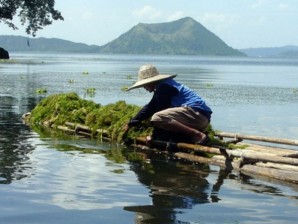Project turns seaweed into ‘pancit from the sea’

A farmer harvests seaweed along the Taal lake while the Taal volcano is seen in the background in this photo taken in September 2005. AFP FILE PHOTO
MANILA, Philippines—It’s “pancit” from the sea—a sea vegetable in the form of a favorite staple.
Nutritious noodles made from seaweed are bringing new hope to poor families in Bicol and raising the incomes of seaweed farmers there, according to the Bureau of Agricultural Research (BAR) of the Department of Agriculture (DA).
BAR Director Nicomedes P. Eleazar said a project funded by his agency to process seaweed into noodles “has already practically spread all over the Philippines,” under the bureau’s Community-based Participatory Action Research program.
“It turned out that the program helped the men flourish in their seaweed farming, while the women started engaging in processing,” he said in a statement Friday.
More than 300 farmers have benefited from the seaweed noodle project, which was started in only two villages in Pilar town in Sorsogon, and spread to other coastal barangays, including Dao, Binanwaan, San Rafael and San Antonio.
Article continues after this advertisementNoodle makers
Article continues after this advertisementAfter the program’s success in Bicol, nearby Iloilo province showed an interest and asked for training in noodle production, Eleazar said.
The Bureau of Fisheries and Aquatic Resources (BFAR) is seeking accreditation by the Food and Drug Administration (FDA) for a seaweed noodle manufacturing facility in the province.
“The manufacturing facility will mark a big milestone for this seaweed noodle-producing community-based program funded by the DA’s Bureau of Agricultural Research,” said Aida Andayog, manager of BFAR-Regional Fisheries Research and Development Center in Region V.
“We can export the product once it’s FDA-approved,” she said.
Andayog said the main beneficiary would be the Tabaco Faith International Church Ladies’ Association, composed of 35 women from eight barangays in Tabaco City.
BAR has initially released P700,000 for the first phase of the project, which has an approved budget of P2 million, and it is expected to release P1.3 million more.
Biggest producer
Eleazar said the bureau has been a consistent supporter of the seaweed industry as it is fit for growing in many coastal areas.
“The country has to take advantage of the fact that it is one of the world’s biggest seaweed producers in order to generate jobs, particularly in coastal towns,” he said.
The country is one of the world’s biggest producers of seaweed and the semi-processed seaweed product, carrageenan.
As of 2003, raw dried seaweed export was at $15.07 million; refined carrageenan, $41.4 million, and semi-refined carrageenan, $87.1 million. From 2004 to 2005, it topped production of food-grade carrageenan, raw dried seaweed and alkali-treated chips.
The Philippines has more than 100 species of seaweed with many industrial or pharmaceutical uses.
Seaweed is rich in iodine, an essential trace element for the body’s growth, removal of body toxins and prevention of mental retardation, goiters and other diseases. It is also a source of protein, Vitamin A and other micro nutrients, such as calcium, magnesium and potassium.